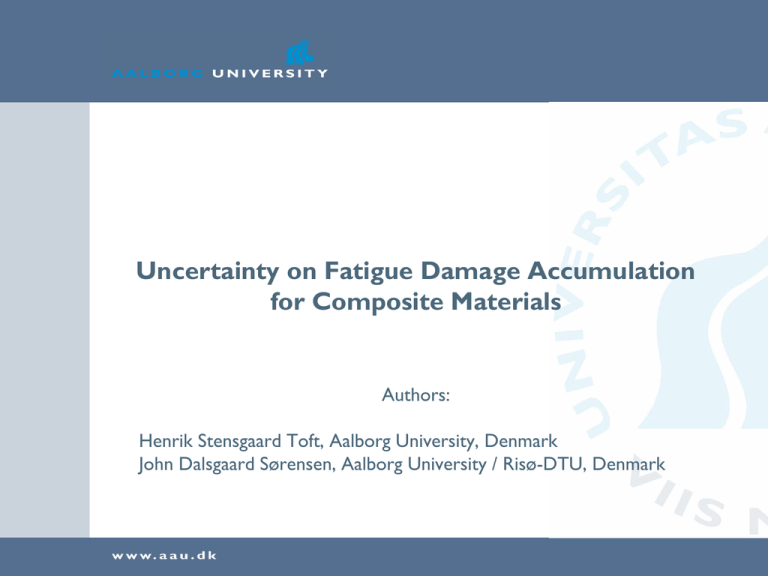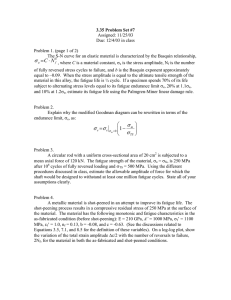Uncertainty on Fatigue Damage Accumulation for Composite Materials
advertisement

Uncertainty on Fatigue Damage Accumulation for Composite Materials Authors: Henrik Stensgaard Toft, Aalborg University, Denmark John Dalsgaard Sørensen, Aalborg University / Risø-DTU, Denmark Contents • Introduction • Composite Material used for Testing • Constant Amplitude Fatigue Tests • Variable Amplitude Fatigue Tests • Conclusion and Future Work www.dong.dk www.vestas.com Introduction Fatigue design of composite material is normally performed using a deterministic design approach. The uncertainties related to fatigue design are in general large which allows for adopting a probabilistic design approach where the uncertainties can be treated in a rational manner. The objective of the present work is establish probabilistic models for: • Uncertainty on the SN-curve • Uncertainty on damage accumulation Primary focus on composite materials used in wind turbine blades. Introduction Deterministic fatigue design is normally based on a: • • Linear SN-curve (log-log scale) Miner Rule for linear damage accumulation Other types of SN-curves and damage accumulation models have been proposed, see e.g. [1,2]. [1] V.A. Passipoularidis, Fatigue Evaluation Algorithms: Review, Materials Research Division, RisøDTU, 2009. [2] N.L. Post, S.W. Case, J.J. Lesko, Modelling the variable amplitude fatigue of composite materials: A review and evaluation of the state of the art for spectrum loading, Int. J. Fatigue, 30 (2008), pp. 20642086. Introduction Uncertainties can in general be divided into three groups: • Physical uncertainty (Aleatory uncertainty) • Model uncertainty (Epistemic uncertainty) • Statistical uncertainty (Epistemic uncertainty) www.lmglasfiber.com Composite Material used for Testing Material Database: • OptiDAT database (www.kc-wmc.nl) Composite material: • Epoxy Glass Fiber Reinforced Plastic (GFRP) Geometry: • • • Geometry R04 MD Lay-up: [[45, 0]4; 45] Size: 25 x 150mm www.kc-wmc.nl Constant Amplitude Fatigue Tests For composite materials the fatigue strength is dependent on the mean stress. Therefore several SN-curves are collected in a Constant Life Diagram using: • Constant amplitude data for 7 different R-ratios. 300 400 N=10 3 N=10 4 N=10 5 N=10 5 N=10 300 6 N=10 7 N=10 R=10.0 R=-2.5 R=-0.4 6 N=10 7 N=10 8 200 R=0.1 9 200 N=10 8 R=10.0 N=10 9 amp [MPa] N=10 min max R=-1.0 N=10 3 R=-1.0 4 N=10 amp [MPa] R R=0.1 R=2.0 R=0.5 100 100 0 -800 -600 -400 -200 0 200 mean [MPa] 400 600 800 1000 0 -600 -400 -200 0 mean [MPa] 200 400 600 Constant Amplitude Fatigue Tests SN-curves are fitted using the Maximum-Likelihood Method in order to model the physical and statistical uncertainties. log N log K m log The Likelihood function is given by: 1 log N log K m log 2 i i L log K , exp 2 2 i 1 n n0 log N i log K m log i i n 1 n 1 The statistical uncertainty is calculated using the Hessian Matrix: Clog K , 2 log K H log K , log K , log K 1 log K , log K 2 Constant Amplitude Fatigue Tests Parameters in SN-curves: m log K logK R-ratio Tests n Runouts n0 0.5 15 0 10.541 27.768 0.358 0.092 0.065 0.1 45 2 9.508 27.191 0.259 0.039 0.027 -0.4 28 0 7.582 23.398 0.435 0.082 0.058 -1.0 84 3 6.719 21.359 0.878 0.094 0.068 -2.5 10 2 11.983 35.231 0.633 0.197 0.143 10.0 34 0 22.211 58.664 0.644 0.110 0.078 2.0 6 3 29.686 73.780 0.354 0.143 0.103 Static tension and compression strength: Test-type Tests n Mean [MPa] Std. [MPa] STT 66 556.5 64.2 STC 55 -458.6 33.2 Constant Amplitude Fatigue Tests R = 0.1 R = -1.0 400 800 700 600 500 stress range stress range 300 200 100 2 10 3 4 10 5 6 10 10 cycles to failure N 10 400 300 200 100 2 10 7 10 3 4 10 5 6 10 10 cycles to failure N 10 7 10 R = -0.4 R = 2.0 500 250 400 stress range stress range 225 200 175 150 3 10 4 10 5 10 cycles to failure N 6 10 7 10 300 200 100 2 10 4 6 10 10 cycles to failure N 8 10 Constant Amplitude Fatigue Tests 300 R=-1.0 N=10 3 N=10 4 N=10 5 N=10 R=-2.5 R=-0.4 6 N=10 7 200 N=10 8 R=10.0 amp [MPa] N=10 9 R=0.1 R=2.0 R=0.5 100 0 -600 -400 -200 0 mean [MPa] 200 400 600 Variable Amplitude Fatigue Tests The model uncertainty related to Miners rule for damage accumulation is determined based on variable amplitude fatigue tests. Load spectra's • Wisper spectrum • WisperX spectrum n D i 1 1 N i 40 30 Level [-] 20 10 0 -10 WISPER WISPERX -20 -30 0 0.5 1 1.5 Peak [-] 2 2.5 x 10 5 Variable Amplitude Fatigue Tests Mean and standard deviation for accumulated damage at failure. Spectrum Tests N Mean Std. COVD Wisper 10 0.9000 0.5355 0.595 Wisperx 13 0.2763 0.1982 0.717 Reverse Wisper 2 0.2020 - - Reverse Wisperx 10 0.3179 0.1576 0.496 Wisper, Wisperx 23 0.5474 0.4886 0.893 All 35 0.4621 0.4196 0.908 • High uncertainties compared e.g. welded steel details. • Significant model uncertainty related to Miners rule for composite materials. • Lognormal distribution (negative damage avoided) Conclusion & Future Work Fatigue design contains the following uncertainties: • • • Physical uncertainty: Statistical uncertainty: Model uncertainty: SN-curves Parameters in the SN-curves Miners rule Model uncertainty on Miners rule can be modelled by a Lognormal distribution with mean and standard deviation equal to approx. 0,50. Partial safety factors for fatigue design of wind turbine blades can be calibrated using the stochastic models given in the present paper. www.vestas.com Uncertainty on Fatigue Damage Accumulation for Composite Materials Authors: Henrik Stensgaard Toft, Aalborg University, Denmark John Dalsgaard Sørensen, Aalborg University / Risø-DTU, Denmark



